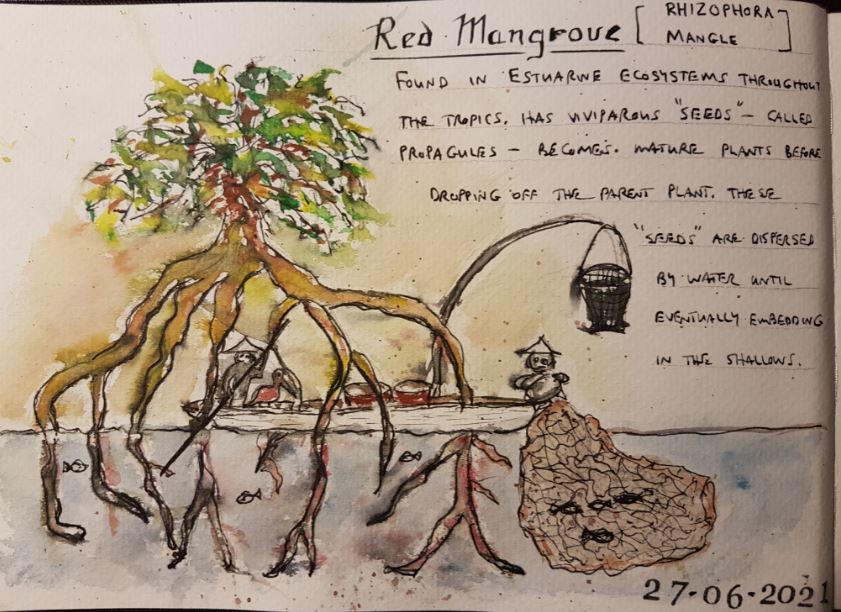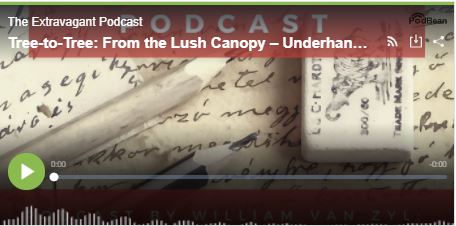
By William Van Zyl (June 2021)
Listen to the podcast while reading: https://www.podbean.com/ew/pb-sbg2d-11678c1
An encoded scent whiffed across to a neighbouring tree. It had a complex message in the transparent envelope. The postman did not deliver it. Mister Wind carried it with unseen dedication. Leaf-to-leaf, the proverbial ‘drums’ had relayed the detailed message.
The ‘letter’ in the envelope read:
“Red Alert! There is an insect attack on me! Prepare – chemically – to protect yourself (the tree).”
“Hey, I have to do something – quick. Insects are in the tree next to me,” whispered the leaves of the large Birch tree.
It took about 20 minutes. The leaves of the tree turned ‘bitter.’ Inedible. The insects left the second tree without touching a leaf.
This is a simple example of how trees in a forest work together to warn and protect one another. They use messages we humans can’t see.
The Secret Life of Trees
I have recently downloaded an audiobook from Audible with the title The Hidden Life of Trees – the editor’s choice. When I listened to the foreword and the first chapter, a clear thought entered my head.
Trees are more, much more than what we ever expected. The fantastic book by Peter Wohlleben – The Hidden Life of Trees – confirms the many books and videos that are out there claiming the ‘Gospel’. What trees are to us, or for us, is mind-blowing. They are relational miracles. They do not exist independently but they have their own entangled, complex, and symbiotic webs of inter-being. They are constantly communicating with one another. They use chemical signals which they dispatch along with the fungal networks that live in their roots. You will be stunned by the revelation of the invisible, astonishing underworld – and upper-world – only recently discovered.
For your information, I have produced a special link to an unexpected source you would never have thought of – not in your wildest dreams. Wait for it.

I am also acknowledging the work of other scientists. Thanks to Canadian forest ecologist Suzanne Simard from Canada.
Video: Suzanne Simard
“A forest is much more than what you see,” says Suzanne Simard. Her 30 years of research in Canadian forests have led to an astounding discovery — trees talk, often and over vast distances. Learn more about trees’ harmonious yet complicated social lives and prepare to see the natural world with new eyes. Source: YouTube (Suzanne Simard).
A philosophical and literary description: An introduction to trees
“The tree which moves some to tears of joy is in the eyes of others only a green thing which stands in the way,” William Blake wrote in his most beautiful letter. Walt Whitman found in trees a model of existential authenticity. Hermann Hesse saw them as the wisest of teachers. Wangari Maathai won the Nobel Peace Prize for her noble work of planting trees as resistance and empowerment.
Credit: MARIA POPOVA – https://www.brainpickings.org/2019/07/10/trees-ted-ed/
This article focuses on tree communication – above ground and underground. Then, the author endeavours to highlight a parallel between trees and humans. Humans are like trees. But how, you may ask.
Most people are definitely like trees. Yes, you probably know that. However, you will not believe where I have read it. The verse I am going to quote is related to this statement. If you continue reading, you will see it. Stunning—totally unexpected.
And when He had spit on his eyes and put His hands on him, He asked him if he saw anything. And he looked up and said, “I see men like trees, walking.”… Peter, after the blind man in Mark 8 receiving his sight, gives a radical confession of faith, “You are the Christ!” (Mark 8:27-30).
There you have it.
After the miraculous power of Yeshua – the saliva of the firstborn sons was believed to contain healing powers in Jewish tradition – had rested on the blind man, his spiritual eyes were opened. He saw the spiritual outline of people – walking around like trees. At that very moment, there is a revelation. The second miracle is the restoration of the blind man’s sight.
Humans are like trees, confirmed 2000 years later (after the blind received his sight) – by scientific research and observation. Peter Wohlleben and Suzanne Simard are some of the many scientists who had the revelation: Trees are like communities of people – they live and work together.
What stunned me – after listening to the audiobook – was that trees work together. Not competing, as most people would expect. They are communicating above the ground and below the ground. They use intricate, extravagant chemical messages, encoded scents, rich electrical pulses, and more to help one another. They don’t fight to be the fittest and the strongest in the forest. They work together; they know they are stronger together. They need each other to survive.
Suzanne Simard explains how trees communicate underground:
Trees can communicate with each other through a vast root system and symbiotic fungi called mycorrhizae. See the insightful video.
The concept of the survival of the fittest and natural selection is not to be found amongst the trees in forests; on the contrary, they are friendly communities
I now refer to Darwin’s first attempt at mapping out his tree of evolution. His overall argument is that species evolve from one another and that those species, with similar traits to others, have a less likely chance at survival. He titled this theory Natural Selection (survival of the fittest), and it’s widely used amongst environmental studies.
DEFINITION – NATURAL SELECTION: Natural selection is defined as a process by which species of animals and plants that are best adapted to their environment survive and reproduce, while those that are less well adapted die out.
I include the fascinating, authentic note, and a sketch of Charles Darwin here.

Interpretation of handwriting: “I think the case must be that one generation should have as many living as now. To do this and to have as many species in the same genus (as is) requires extinction. Thus between A + B the an immense gap of relation. C + B the finest gradation. B+D rather greater distinction. Thus genera would be formed. Bearing relation” (next page begins) “to ancient types with several extinct forms”.
Text in Darwin’s format:
36
(text)
I think
(tree graph)
B
D C
1 A
(text on the side)
Case must be that one
generation then should be
as many living as now.
To do this & to have many species in
same genus (as is) requires extinction.
(text below tree graph)
Thus between A & B immense
gap of relation. C & B the
finest gradation, B & D
rather greater distinction.
Thus genera would be
formed. — bearing relation
Maybe, just maybe, Darwin was just too quick with his TREE OF LIFE sketch. He did not know about the secret life of trees at that stage. However, Mr Darwin, great scientific work!
Trees: Survival of the Friendliest – not Survival of the Fittest
“Survival of the fittest” often brings to mind a notion that physical strength and power are crucial to survival, but that’s a misconception. Evolutionarily, the best refers to a species’ ability to reproduce and create an environment where its offspring can flourish. Scientists have found that being able to cooperate and form strong relationships is often essential to species survival, and it’s seen when we examine the evolutionary success of our human ancestors, apes, and even our dogs. For that reason, some might say friendliness actually beats out fitness when it comes to survival.
Trees are inherently friendly. The friendlier a tree, the better chances it has to survive. The book The Secret Life of Trees confirms the notion. It opposes the evolutionary theory of Darwin of the fittest’s survival (natural selection). Wohlleben points out that trees communicate on many levels. They help one another. They feed each other in crises times; they warn one another via chemical and electrical pulses (insect attacks, and more). This new knowledge is a game-changer.
How refreshing is it to realise that humans can prosper by helping others – just like trees.
Give, and it will be given to you: good measure, pressed down, shaken together, and running over will be put into your bosom. For with the same measure that you use, it will be measured back to you.” Luke 6:38 NKJV

So, as humans, what can we learn from trees?
Here are 4 simple things we can learn from trees standing together in the forest and under the same canopy.
1. Humans should love their neighbouring trees as themselves. Give.
Humans should uproot greed, selfishness, and self-indulgence with a vengeance. A caveat here, we should grow entrepreneurs with an unselfish character. This starts in schools and in the shaping of a nation’s culture. The leaders have to model the way. For example, when a wealthy prime minister or president takes the lead by giving their salary — or half their salary — away to a charity. What a lofty and magnificent ‘tree.’
2. It not about the fittest surviving and the elimination of the weak.
Think about an assumable ‘dead stump’ in the forest supported by surrounding trees for hundreds of years. We should look after our weak, frail, and special needs neighbours. Not the evolution model — for example, Darwinian theories — where the fittest survives at all cost. But, the Christian model:
Romans 13: 8-10
8 Let no debt remain outstanding, except the continuing debt to love one another, for whoever loves others has fulfilled the law. 9 The commandments, “You shall not commit adultery,” “You shall not murder,” “You shall not steal,” “You shall not covet,” and whatever other command there may be, are summed up in this one command: “Love your neighbour as yourself.” 10 Love does no harm to a neighbour. Therefore, love is the fulfilment of the law.
3. Alert others and stand up for what is right — fight the rot.
When damaging insects — or large herds of animals — attack a tree, the tree involved will alert the surrounding trees using a scented message. We should look out for one another. Show love, care and offer discreet advice to our neighbours. For example, receiving bad news and pandemics affecting people and their income. Other attacks on ‘trees’ could be family violence, addictions, mental health issues, and more.
You are the salt of the earth – fight the rot
4. Share, support, and serve.
Trees are unselfish. They give; they support surrounding trees. They know they are stronger together. They will survive longer if they work together. The tree-culture of sharing is terrific.
Ephesians 4:28
28 Anyone who has been stealing must steal no longer but must work, doing something useful with their own hands, that they may have something to share with those in need. NIV
More resources and interesting reads:
The Fascinating Science of How Trees Communicate, Animated. By Maria Popova. https://www.brainpickings.org/2019/07/10/trees-ted-ed/\
Interview with Peter Wohlleben
Forests contain much more than meets the eye, writes Peter Wohlleben in his groundbreaking book The Hidden Life of Trees. Within the roots of trees are active brain-like processes, and trees are capable of communication and learning. A forester, Peter Wohlleben, tells host Steve Curwood about the unseen and unsung connections between trees and how humans can better care for them. Listen to the interview here or read the transcript:
https://www.loe.org/shows/segments.html?programID=18-P13-00033&segmentID=6
Copyright © 2021 by William Van Zyl
Tree-to-Tree: From the Lush Canopy – Underhanded and Ciphered – a Message to Thee.
All rights reserved. This book or any portion
thereof may not be reproduced or used in any manner
whatsoever without the express written permission of the
publisher except for the use of brief quotations in a book review.
Published by Five House Publishing (New Zealand)
First Publishing, 2021

More ebooks and articles available at https://fivehousepublishing.com/
More about the author at http://williamvanzyl.com/
